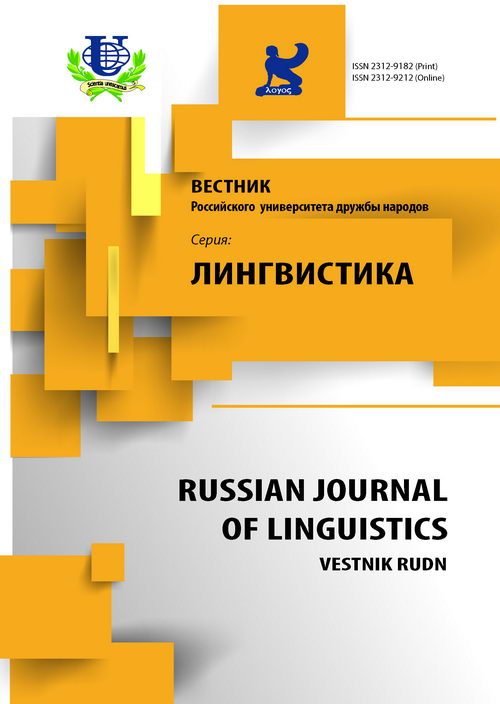External and Internal Conditionality of Language Borrowing
- Authors: Bukina L.M.1
-
Affiliations:
- State Socio-Humanitarian University
- Issue: Vol 20, No 1 (2016)
- Pages: 89-99
- Section: Articles
- URL: https://journals.rudn.ru/linguistics/article/view/9661
- ID: 9661
Cite item
Full Text
Abstract
This article looks at the factors that condition borrowings in language. The exposure of borrowings in the language system is based on precise differentiation of intralinguistic and extralinguistic factors. The theoretical basis for this study were the works of Russian and foreign scientists (Bagana Zh., Breiter M.A., Crystal D., Kryisin L.P., et al) who were interested in such diversified phenomena as borrowings, in general, and in particular the reasons for them. Research is being conducted on the basis of the French language, certain illustrative units derived empirically in the process of researching these French websites: http://www.linternaute.com, http://www.elle.fr, http://www.wuzz.fr, http://www.eurosport.fr, etc. Borrowing can occur on all levels of language, but we considered the factors that facilitate borrowing and assimilation in the recipient language of lexical borrowings. The research is aimed at considering points of view of different linguists on the problem of borrowing into the recipient language and revealing similarities and differences in the views of scientists. Notwithstanding the fact that external reasons are acting as stimuli for borrowing, there are many linguistic research works that highlight their importance in the appearance and customization of foreign words in the recipient language. Intralinguistic factors dominate in the process of adopting a foreign word into the vocabulary of another language. Psychological factors play one of the key roles in the appearance of borrowings, as language contact is performed when bilingual speakers who have separate linguistic identities communicate. During the research the following methods were used: continuous sampling method, descriptive and analytical method, method of semantic analysis, method of comparison and contrasting.
About the authors
Liliya Mikhaylovna Bukina
State Socio-Humanitarian University
Email: lilehka1985@gmail.com
Department of French and German Languages Faculty of Foreign Languages
References
- Багана Ж., Бондаренко Е.В. Ассимиляция заимствований из французского языка в среднеанглийских диалектах: Монография. М.: Инфра-М, 2012.
- Богданова Л.И. Новые слова в аспекте взаимодействия языков и культур // Вестник РУДН. Серия «Лингвистика». 2015. № 2. С. 41-48.
- Богородицкий А.В. Общий курс русской грамматики: (Из университетских чтений). Изд. 4-е, доп. Казань: Типолитогр. Имп. ун-та, 1913.
- Брейтер М.А. Англицизмы в русском языке: история и перспективы: Пособие для иностранных студентов-русистов. Владивосток: изд-во «Диалог», 1997.
- Вайнрайх У. Языковые контакты. Состояние и проблемы исследования. Киев: Вища школа, 1979.
- Волков С.С., Сенько Е.В. Неологизмы и внутренние стимулы языкового развития // Новые слова и словари новых слов. Л.: Наука, 1983.
- Костюшкина Г.М., Горбунова И.В. Стратегический аспект англицизмов в интернет-дискурсе // Вестник Челябинского Государственного университета. 2011. № 33. С. 75-77.
- Крысин Л.П. Русское слово, свое и чужое: Исследования по современному русскому языку и социолингвистике. М.: Языки славянской культуры, 2004.
- Лотте Д.С. Вопросы заимствования и упорядочения иноязычных терминов и терминоэлементов. М.: Наука, 1982.
- Майоров А.П. Социальные аспекты взаимодействия языков в билингвистическом коммуникативном пространстве. Уфа: БГМУ, 1997.
- Мангушев С.В., Павлова А.В. Экстралингвистическая и внутриструктурная обусловленность языкового контакта // Вестник Оренбургского государственного университета. 2004. № 11. С. 157-160.
- Сидоров А.А. Английская экспансия в современном французском языке // Вестник Волжского университета им. В.Н. Татищева. 2013. № 3 (13). С. 51-61.
- Смецкой А.И. О некоторых внутренних тенденциях развития лексики в связи с проблемой заимствования // Вопросы романо-германской филологии. 1975. Т. 54 (157). С. 97-121.
- Hope T.E. Loan-words as cultural and lexical symbols. Glasgow. 1962.Vol. 14. Fasc. 2.
- Richter E. Fremdwortkunde. Lepzig, 1919.
- URL: http://www.e reading.club/bookreader.php/91243/Besser_Zigmund_-_Magicheskie_ slova.html. EXTERNAL AND INTERNAL CONDITIONALITY
Supplementary files















